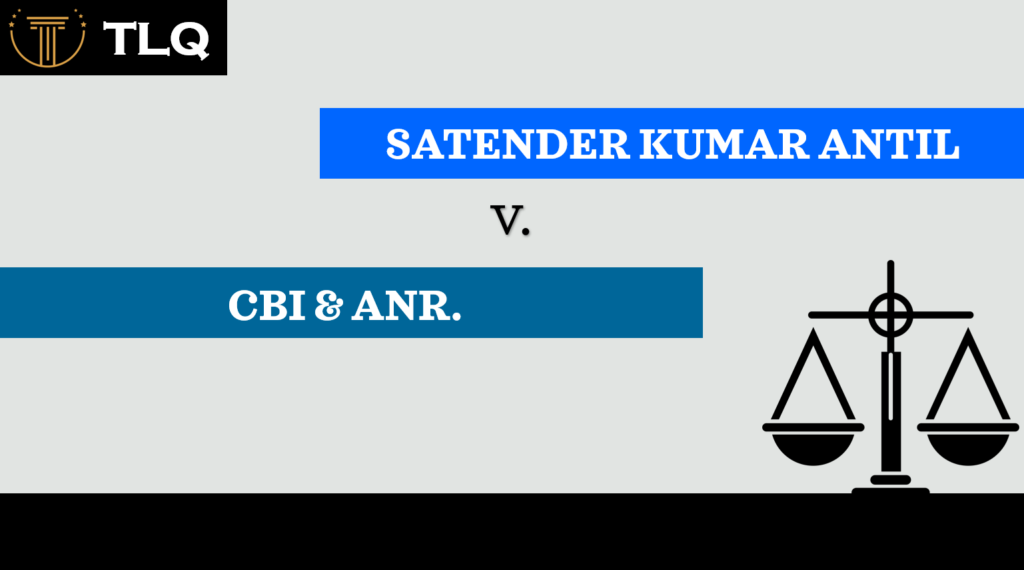Published on 04th July 2025
Authored By: Himanshi Bansal
Lloyd Law College
Abstract
The case of Shrimati Shantabai v. State of Bombay (1953) is an interpretation of property rights under Article 19(1)(f) of the Indian Constitution (since repealed). The nature of rights in trees growing on leased forest land. The article is dedicated to looking at the scenarios that were upheld by the Court. The state’s authority to regulate forest use in the public interest and ruled that the restriction did not amount to an unconstitutional deprivation of property under Article 19(1)(f), since it was a reasonable restriction under Article 19(5).
Key words: Constitutional case, Fundamental rights, Verdict, Preamble, Basic features, seized, ratio decidendi, Independence, agreement, regulated rights
Introduction
The present document aims to demonstrate the case Shrimati Shantabai v. State of Bombay (1953), which is an important and also considered an early verdict given by the Supreme Court of India about the right to property. In this case, Shantabai (the petitioner) had taken forest land on lease and believed she had the right to cut and sell the trees growing on it. However, the act of deterrence was made by the government, arguing that it didn’t own the trees. The plaintiff went to court, arguing that her property rights were being violated under the Constitution. The main issue was whether she had the right to use the trees as her property. The verdict shall be discussed in detail.
What is a Constitutional case?
A constitutional case refers to a legal dispute focused on the interpretation, application, or validity of a constitution. It is a fundamental law that outlines the structure and powers of a government. The Constitution is the supreme law in every country and the apex authority concerning laws for its citizens and governing their behaviour as well as ensuring their legal rights, also safeguards them from any infringement or discrimination.
The major areas covered by the constitutional law are –
- Rights
- Basic human rights
- Balance of power
- Legality of governmental organisation
- Electoral laws/democracy
- Religion and secularism
- Emergency powers
Constitution of India
The Constitution in India is regarded as the rule book of law, which is also the longest written constitution. The constitution has access to every legal aspect of Indian society. These aspects are directly or indirectly governed by the Indian Constitution. It also provides the legal framework for political principles, government structure, and the rights and duties of citizens.
Preamble
The preamble is a brief introductory statement that sets out the core values, objectives, and philosophy of the Constitution. It is a reflection of the spirit and purpose of the document and serves as a guiding light for interpreting the Constitution’s provisions.
The preamble begins with – WE, THE PEOPLE OF INDIA,
Some of the basic features that cannot be changed are – Sovereign, Socialist, Secular, Democratic, Republic, Justice, Liberty, Equality, Fraternity. [1]
In 1976, there was an amendment made – The 42nd Constitutional Amendment
During this period, there were some terms added the words “Socialist”, “Secular”, and “Integrity”.
Constitutional law
The body of rules, doctrines, and practices that govern the operation of political communities. It establishes rules and procedures by which the government operates. Legislate, or make a law.
Some of the constitutional cases are;
- State of Madras v. Amt. Champakam Dorairajan (1951)[2]
- C. Golak Nath and ors. Vs. State of Punjab and Anr. (1967)[3]
- Keshavananda Bharati v. State of Kerala (1973)
- Minerva Mills Ltd. V. UOI (1980)
Shrimati Shantabai vs. State of Bombay (1958 AIR 532, 1959 SCR 256)
Bench: Das, Sudhi Ranjan (Chief Justice), Ayyar, T.L. Venkatarama, Das, S.K., Sarkar, A.K., Bose, Vivian[4]
Petitioner: Shri Shantabai
Vs.
Respondent: State of Bombay
Judgment date: 24 March 1958[5]
Nature of the case: Civil in nature.
References of the Other cases involved:
(1) Ananda Behera Vs. State of Orissa.[6]
(2) Chhotabhai Jethabhai Patel and Co. Vs. The state of Madhya Pradesh[7]
Statutes referred to in the case
- The Indian Constitution
19 (I) (f) 19 (1) (g)
- The Madhya Pradesh proprietary Abolition Act 1950.
Section 32 and Section 3
Issue involved in the case
The petitioner raised the issue that her fundamental rights were being infringed. The fundamental rights mentioned by the petitioner were 19 (I) (f) and 19 (1) (g).
However, it was stated that no fundamental rights of the petitioner were infringed under the mentioned article of the Indian Constitution, and also that the petition must be dismissed.
The reason stated was that the Madhya Pradesh government. It was not in the agreement, as that was an oral agreement made by the petitioners’ husband (Shri Balirambahu Doye) to her (the petitioner), registration of the transferred property was not done. Which made it obvious that the government. Of Madhya Pradesh would be unknown about the transaction, which also gives the point that the Madhya Pradesh government. Didn’t infringe the right of the petitioner.
Questioning on the construction of the deed under Section 8 of the Transfer of Property Act was also raised.
Facts of the case
- April 26, 1948; Petitioners’ husband (Shri Balirambahu Doye), the zamindar of Pandharpur, proprietor of certain forest nearby 8 tehsils. He granted the petitioner that land for a certain time.
- He (the petitioners’ husband) made an unregistered document, which was called a lease.
- The tenure granted to the petitioner was about 12 years, starting from the year 1948 to 1960.
- A sum of twenty-six thousand rupees was paid by the petitioner for the consideration of the property granted to her.
- All the above-stated transaction was done verbally, registration of the document was not done by either the petitioner or her husband.
- Whereas the registration of the document under the Indian Registration Act is mandatory
- Document not being registered under the Indian Registration Act gives her no right to claim or acquire benefits of the property (immovable property).
- In the year 1951, the Madhya Pradesh govt. Introduced some rights under the property rights.
- Under S.3[8] The state has vested the abolition of property rights (estate, mahals, alienated land) Act 1950 – in that case, the petitioner can only claim for compensation.
- The petitioner applied to the deputy commissioner of the area and obtained an order permitting her the continue working in the forest, and after the permission, the work of cutting down the woods had started.
- Some actions were taken by the Divisional Forest officer against the petitioner, passing an order that her name could be cancelled and the cut material could be seized.
- Petitioner, after that, moved to the state govt. Against the order, but that wasn’t effective.
- After which, the petitioner moved to the Supreme Court under section 32.
- Even if the document acts as a license coupled with a grant, then the rights acquired by her (petitioner) would be profitable, which ultimately gives rise to the interest in land (immoveable property).
- The profits still couldn’t be gained as the property wasn’t registered under the Indian Registration Act.
- The document is construed as a matter of contract. Petitioner cannot complain as the state wasn’t part of the contract made by the two aggrieved parties, nor was the state a party to some claims, clauses, or benefits that could have been gained out of that land.
- Petitioner stated that she had been granted the land for 12 years, however, she worked there only for 2 years, 1948 – 1950.
- 26 August 1957, the Madhya Pradesh govt. Launched the Abolition of Proprietary Act 1950, which restrained her from working.
Ratio decidendi
(reason for the decision)
The ratio decidendi of the case is –
That there was no infringement of the petitioner’s fundamental rights stated under the Indian Constitution. As the Madhya Pradesh government. Wasn’t part of the contract or got any benefits from it, nor by any policy of the Madhya Pradesh government. Act.
Significance of this case
The case of Shrimati Shantabai v. State of Bombay holds importance or is significant because of its early clarification on property rights work under the Indian Constitution, especially during the early years after independence.
The case worked as a catalyst by helping the courts with a base to develop a balance between individual rights and public interest, it also played a role in shaping how property and environmental laws are understood in India today.
- Property rights can be regulated – the government has the authority to regulate and use the land as per the needs as they arise. It also tells how the government can limit access in order to control how natural resources like forests are used, especially when it’s for the benefit of the public.
- Property is not an absolute right – through this case, it was brought into a big picture that property rights are not absolute.
- Limited rights – the case clarified that just because an individual has land on lease does not mean they fully own everything on that land, for example, trees or minerals.
- Guidance to a newly independent state – the case also worked as base on how a balance should be maintained between personal liberty with the state’s duty to ensure justice and equality.
Impact
The case of Shrimati Shantabai v. State of Bombay is not such a highlighted or limelight case, but its importance in shaping today’s understanding of property law cannot be neglected. The Supreme Court made it clear in its verdict that just because you lease land doesn’t mean you own everything on it, like trees or natural resources.
The case also impacts as it reminded the pupil that fundamental rights are guaranteed and cannot be denied anywhere within the territory of India, but can be reasonably restricted by the government of India in times of need.
Example – the emergency period in India
The covid – 19 phases (lockdown)
References
[1] https://www.mygov.in/read-the-preamble-india/
[2] https://blog.finology.in/Legal-news/top-10-landmark-cases-of-constitution
[3] https://blog.finology.in/Legal-news/top-10-landmark-cases-of-constitution
[4] https://indiankanoon.org/doc/963790/
[5] https://indiankanoon.org/doc/963790/
[6] https://indiankanoon.org/doc/258864/




